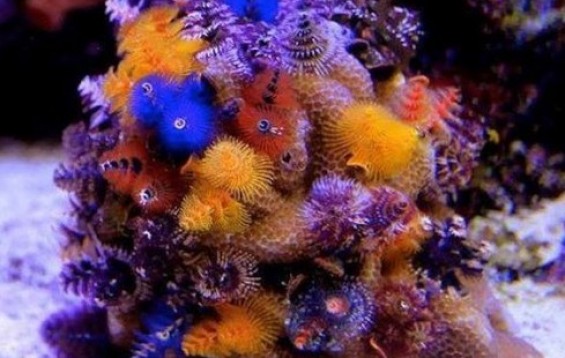- Name:
Christmas Tree Worm Coral
(View AKA's) - Family: Serpulidae
- Species: Fan Worms
- Scientific Name: Spirobranchus porites


General info about Christmas Tree Worm Coral
The Christmas Tree Worm crown comes in a variety of different colors and they grow to about 3.8 cm (1.49 in). Usually, just the crown, which is spiraled in the shape of a Christmas tree, is seen; its body is hidden within the host coral. It has an operculum (top trap door) that covers its tube when it withdraws its crown. There are often several Christmas Tree Worms in the same area, though they do not live in close groups. The Christmas Tree Worm is somewhat shy of movement and prefers to be in the shade of rocky overhangs, out of the bright light.
Christmas Tree Worm Coral Diet & Nutrition
Christmas tree worms are filter feeders that use their radioles when feeding. Radioles are hair-like appendages that look like feathers circling around the central spine. Their diet mostly consists of phytoplankton.
Determining Sex of Christmas Tree Worm Coral
Sexing the Christmas Tree Worm is difficult because some Spirobranchus genus are hermaphrodites.
Breeding & Spawning Christmas Tree Worm Coral
Christmas Tree Worms do not make physical contact when spawning. They merely release their sperm and egg into the water which, upon meeting, fertilize and become an embryo. The embryo develops into larva within 24 hours and settles and burrows on the coral. This phenomenon happens naturally, and they spawn the area together at the same time.
Christmas Tree Worm Coral Origin
Christmas Tree Worms can be found on coral reefs around the world.
Caution with Christmas Tree Worm Coral
It is very intolerant of copper-based medications.
Original Detail
| Name | Species | Family | Scientific Name | More Detail | Added by |
|---|---|---|---|---|---|
| Christmas Tree Worm Coral | Fan Worms | Serpulidae | Spirobranchus porites | The Christmas Tree Worm crown comes in a variety of different colors and they grow to about 3.8 cm (1.49 in). Usually, just the crown, which is spiraled in the shape of a Christmas tree, is seen; its body is hidden within the host coral. It has an operculum (top trap door) that covers its tube when it withdraws its crown. There are often several Christmas Tree Worms in the same area, though they do not live in close groups. The Christmas Tree Worm is somewhat shy of movement and prefers to be in the shade of rocky overhangs, out of the bright light. |
PalaciosAn |
Changed by users
| Submitted Date | Submitted By | Status | Action |
|---|

